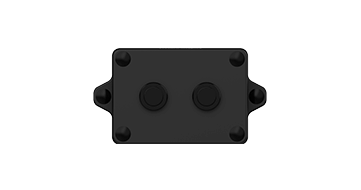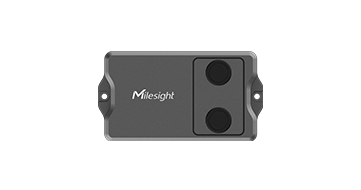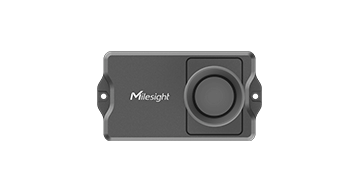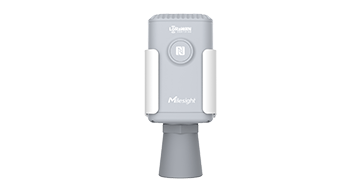How Ultrasonic Distance Sensors Work:
6 Practical Applications


What is an ultrasonic distance sensor?
An ultrasonic distance sensor measures the distance to an object by emitting high-frequency sound waves and detecting the time it takes for the echo to return. It operates on the principle of echolocation, similar to how bats and dolphins navigate their surroundings.
Ultrasonic distance sensors provide precise measurements, are versatile enough to suit different environments, including harsh conditions, and ensure safety and longevity through non-contact measurement. Due to their high accuracy and reliability, these sensors are widely used in various applications. They are commonly deployed in smart cities and automation for waste management, parking lot occupancy detection, and tank level measurement.
Read on to discover how it works, its typical applications, and a strong lineup of Milesight’s ultrasonic distance sensors.
How Do Ultrasonic Sensors Work?
An ultrasonic distance sensor emits ultrasonic waves typically above 20 kHz, beyond human hearing. These waves bounce off objects and return to the sensor so it can measure the time taken for their round trip. Using the speed of sound, the sensor calculates the object's distance based on the time-of-flight (TOF).
Compared to optical sensors, ultrasonic sensors are generally more reliable in scenarios where transparent or reflective surfaces can disrupt light-based measurements. These sensors are widely used in robotics, automotive systems, and industrial automation due to their reliability in detecting objects regardless of lighting conditions.
While radar sensors are better suited for long-range detection, ultrasonic sensors are a practical and cost-effective choice for short to medium-range applications, such as parking management, liquid level monitoring, and smart waste bin systems.
Ultrasonic distance sensors are popular options across industries due to their ability to operate in harsh environments, high sensitivity to nearby objects, ease of use, affordability, and durable performance.
Why Use an Ultrasonic Distance Sensor?
Ultrasonic distance sensors are a popular choice for IoT and industrial applications due to their unique advantages:
High Accuracy
These sensors provide precise distance measurements, even in conditions where lighting or surface texture could affect other technologies.
Cost-Effectiveness
Ultrasonic sensors offer reliable performance at a lower cost, making them ideal for large-scale implementations in smart cities, such as parking and waste management systems.
Non-contact Measurement
By using sound waves, these sensors detect distances without physical contact, reducing wear and ensuring safer operations in applications like sewer monitoring.
Versatility in Various Environments
Ultrasonic sensors perform reliably in harsh conditions, including dusty, wet, or low-light settings, where other sensors might struggle.
Resilience
Milesight ultrasonic sensors feature IP67 ingress protection, ensuring excellent durability against water, dust, and challenging environments, making them suitable for long-term deployment in demanding scenarios.
Applications of Ultrasonic Distance Sensors
Ultrasonic distance sensors enhance smart city solutions, improving efficiency, safety, and sustainability across various applications:
Trash Bins (Different Sizes)
Ultrasonic distance sensors are widely used in trash bins to monitor waste levels. By measuring the fill height, these sensors enable smart waste management systems to optimize collection schedules, reducing operational costs and improving efficiency. This allows waste collection services to be more responsive and environmentally sustainable.
Parking Lot
In parking lots, ultrasonic sensors detect the availability of parking spaces by measuring the distance between the sensor and the ground. This technology enhances user experience and streamlines traffic flow by guiding drivers to vacant spots quickly.
Sewer Monitoring
Ultrasonic sensors are crucial for sewer monitoring, helping to detect blockages or changes in water level. By continuously measuring the distance to the water surface, these sensors provide real-time data, aiding in timely maintenance and preventing costly damage. This proactive approach can also help optimize sewer system performance and prevent system failures.
Tank Level
In industries relying on large tanks, ultrasonic distance sensors offer precise tank-level measurements. By determining the liquid height, these sensors help manage stock and ensure safety, preventing overflow or underfill conditions.
Manhole Cover
Ultrasonic sensors can be installed to monitor the position and status of manhole covers. These sensors alert maintenance teams if a cover is displaced or improperly sealed, preventing safety hazards and ensuring public safety. This technology ensures that manholes remain securely closed, preventing accidents and improving infrastructure maintenance.
Flood Monitoring
In flood-prone areas, ultrasonic distance sensors measure water levels, providing early warnings of rising floodwaters. This capability allows for swift action, reducing property damage and improving disaster preparedness. By enabling early detection, these sensors play a critical role in disaster response and mitigation efforts.
Highlights of Milesight Ultrasonic Distance Sensors
Milesight offers a range of ultrasonic distance sensors designed for precise, non-contact measurement across various applications.
Multiple Network Versions (LoRaWAN & NB-IoT)
Milesight ultrasonic distance sensors support both LoRaWAN and NB-IoT, ensuring reliable connectivity for a wide range of IoT applications, from waste management to industrial monitoring. The dual ultrasonic beams further enhance measurement accuracy, ensuring consistent performance in diverse environments.
Pre-set Modes for Common Applications
Milesight products provide pre-set modes to facilitate deployment for customers. For example, EM400-TLD features "Trash Bin Mode" and "Standard Mode," while the EM400-MUD offers "Parking Lot," "Trash Bin," and "Standard Mode." Combined with device motion detection, these pre-configured settings optimize performance and improve security in specific environments.
Diverse Product Range
With various models offering different accuracy levels, blind zones, and ranges, Milesight sensors provide solutions to meet the specific needs of diverse applications, from simple distance measurement to complex monitoring tasks.
Dual Ultrasonic Beams
Milesight sensors utilize dual ultrasonic beams to enhance detection accuracy and reliability, even in challenging environments. This feature ensures precise measurements for various applications.
Device Motion Detection
Equipped with motion detection capabilities, the sensors can identify device movement or tampering. This provides added security and helps maintain optimal operation in sensitive installations.
Environmental Monitoring Capabilities
In addition to measuring distance, Milesight sensors also monitor key environmental factors such as temperature and tilt. Temperature monitoring can detect if there is any combustion occurring inside trash bins, ensuring safety in waste management. Tilt detection can identify the status of trash bin lids or manhole covers, alerting users if they are improperly closed or displaced, which helps prevent potential hazards.
Easy Deployment & Installation
Designed for simplicity, these sensors are easy to deploy and integrate, reducing setup time and enabling quick installation in a variety of scenarios.
How to Choose the Right Ultrasonic Distance Sensor?
When selecting the right ultrasonic distance sensor, there are several important factors to consider to ensure it fits your specific needs. Below are key points that can guide your decision-making process.
Measurement Range
Assess the minimum and maximum distances you need to measure. Ultrasonic sensors typically offer ranges from a few centimeters to several meters.
Accuracy
Choose a sensor with the appropriate accuracy for your specific application. Higher accuracy often comes at a higher cost.
Operating Environment
Consider the conditions, such as temperature, dust, or moisture, and select a sensor capable of performing reliably in those settings.
Power Consumption
Consider battery life and power consumption based on your application to ensure long-lasting, efficient operation.
Budget Considerations
Account for sensor costs, deployment, maintenance labor, and additional expenses to ensure long-term affordability.
Success Story
-
Milesight’s EM310-UDL Ultrasonic Sensors monitor liquid waste levels in hospitals, offering 24/7 remote tracking and instant alerts via the IoT Platform. These sensors provide accurate, real-time data with easy installation and long battery life, enhancing hospital efficiency and ensuring timely waste disposal.
-
The IoT solution for smart waste bins in Malta uses Milesight EM310-UDL Ultrasonic Sensors to track the fill levels of waste bins across the island. The data is displayed through a website and mobile app, helping to streamline waste collection, avoid overflows, and reduce carbon emissions.
-
Milesight project implements a LoRaWAN®-based system for real-time monitoring of waste bin levels and water leaks in older residential buildings. The solution consists of sensors, gateways, and a control station for data analysis. Cleaning staff receive mobile app notifications when bins are full, ensuring prompt waste collection.








